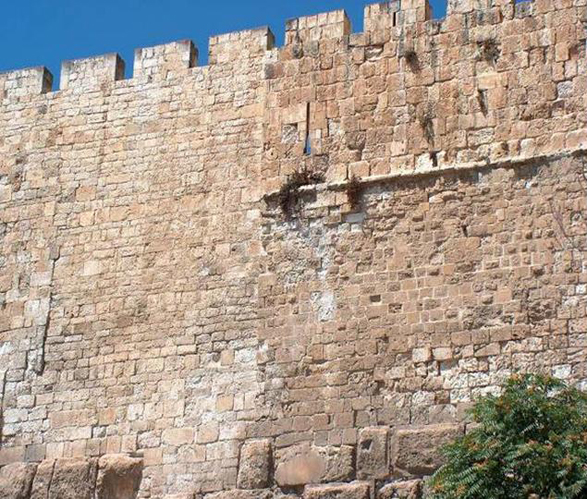The Temple Mount is a 35-acre historic site in the Old City of Jerusalem which is of central importance to Judaism, Islam and Christianity – it was the site of the first and second Jewish Temples in Jerusalem and is the site of two major Muslim religious shrines, the Dome of the Rock and Al-Aqsa Mosque. The mount is contained by an enclosure wall erected to create a level platform on which Herod the Great could rebuild the Jewish Temple in the first century B.C. In February 2004 an earthquake displaced a portion of the mount’s eastern wall. To analyze the deformation and determine whether remediation was needed, the Israel Antiquities Authority engaged Mabat 3D Technologies, Ltd., Tirat-Carmel, Israel, to document and measure the displacement using 3D laser scanning.
Continued
Displacement analysis workflow
Mabat CEO Arik Degani describes how his firm scanned the wall after the earthquake, then compared the resulting data with reference scans taken more than three years earlier. To begin, the survey team placed 15 targets on rocks lying in front of the wall and located these precisely with total station surveying. “We do this to eliminate as much error as possible,” Degani explains. “You need targets to determine whether you have 5mm of displacement in the wall or 10mm – in displacement analysis, every 2mm counts.” Then the team scanned the eastern wall using its Leica HDS2500 (Mabat has since upgraded to an HDS3000). Total field time was between five and six hours.
Data post-processing and extraction of measurements were done in Cyclone. Deliverables were a TIN mesh showing the wall’s geometry after the earthquake compared with before (Figure 3), and sections through the TIN mesh used to generate displacement maps (Figure 4). The TIN mesh and displacement maps were exported to AutoCAD at the client’s request. For every hour of field time, 1.5 to 2 hours of office work were required, Degani reports.
Using this data, the Antiquities Authority determined that earthquake-induced displacement was not severe enough to threaten the wall’s stability, Mabat reports, so immediate remediation was not needed.
Original need – analyzing bulge in southern wall
Baseline data documenting the eastern wall’s pre-earthquake position had been collected by Mabat in an earlier project. As part of an engagement to monitor the walls, in October 2000 the firm was called in to document a bulge in a different location – in this case the mount’s southern wall. This bulge probably resulted from lateral loads exacerbated by construction and excavation activity on the mount, according to Mabat. “At the same time as scanning this bulge,” Degani notes, “we were asked to monitor the southern part of the eastern wall – from the south corner to about 100m away.” Thus the firm had reference data on the eastern wall when the earthquake hit.
Field time to scan the southern wall was likewise five to six hours, including total station-based location of targets. In post-processing, Cyclone was used to cut sections through the point cloud every 25cm and generate contour lines. Displacements of 9-15mm over six months were identified – this was judged significant, and repairs were undertaken as a result.
About Mabat 3D Technologies Ltd.
Mabat 3D Technologies Ltd., Tirat-Carmel, Israel, provides laser scanning and survey services for geodetic, civil, mechanical, aeronautical engineering, cultural heritage, construction, real estate, architecture, topographic, plant and other applications. The firm has nine permanent employees and four contract staff. Laser scanning accounts for 70% of revenue, and high-accuracy total station-based surveying for the remainder.
Presentations by Mabat CEO Arik Degani and others will be featured in a historic preservation track at SPAR 2007: Capturing and Documenting Existing-Conditions Data for Design, Construction and Operations, March 26-27, Houston, TX.






